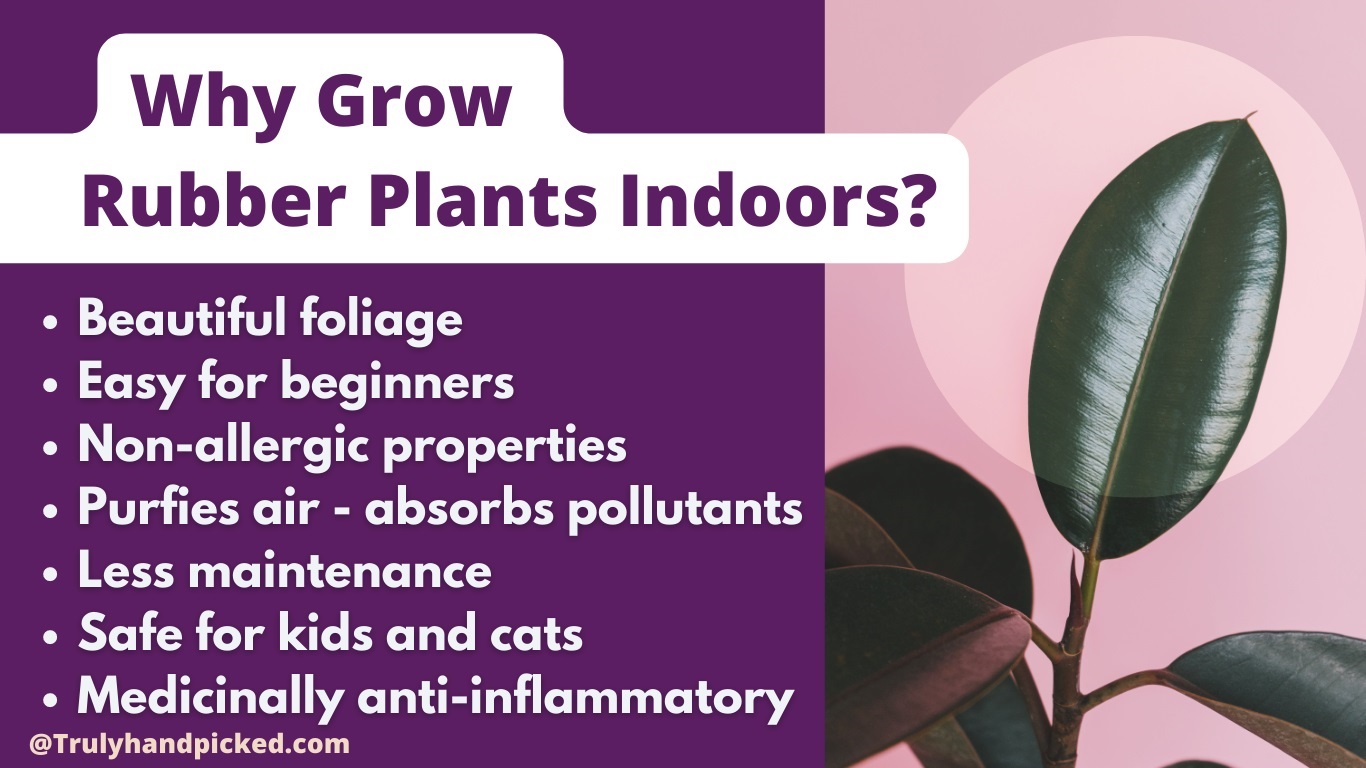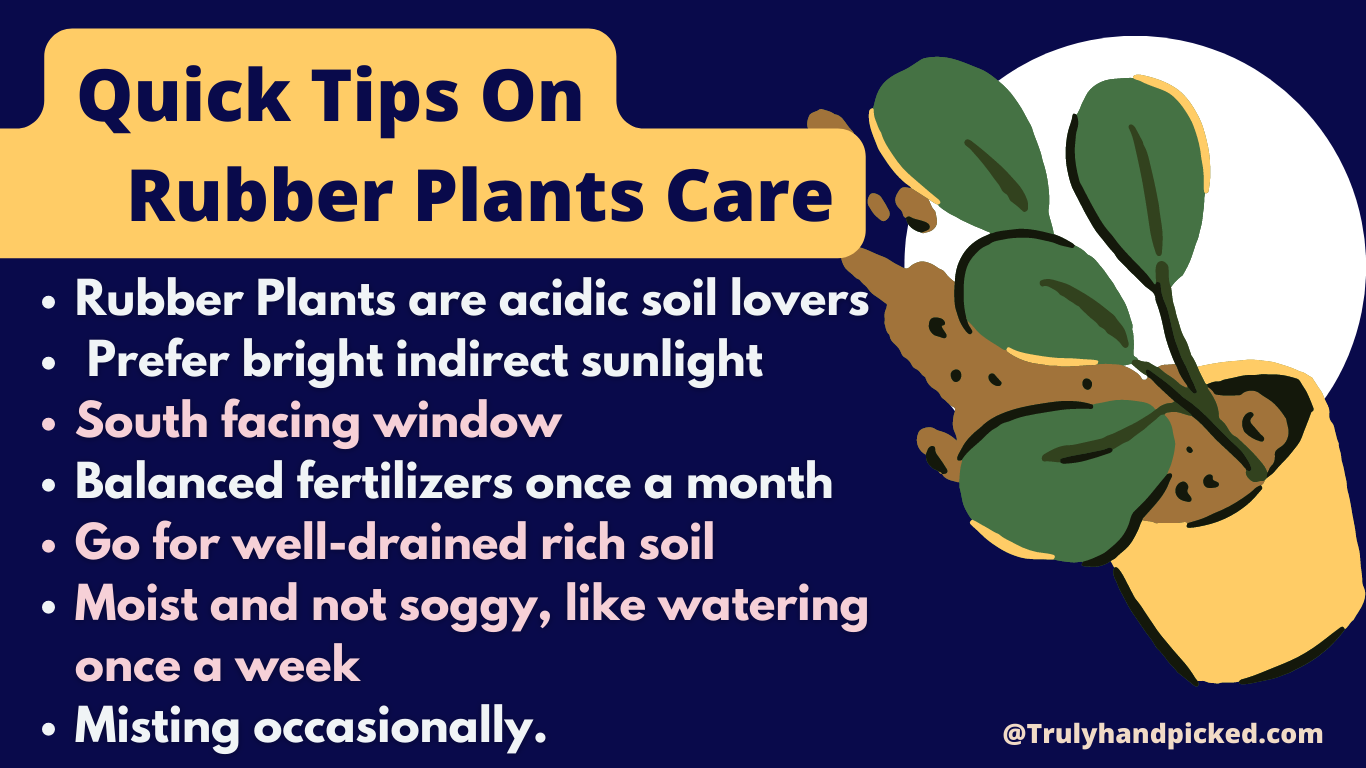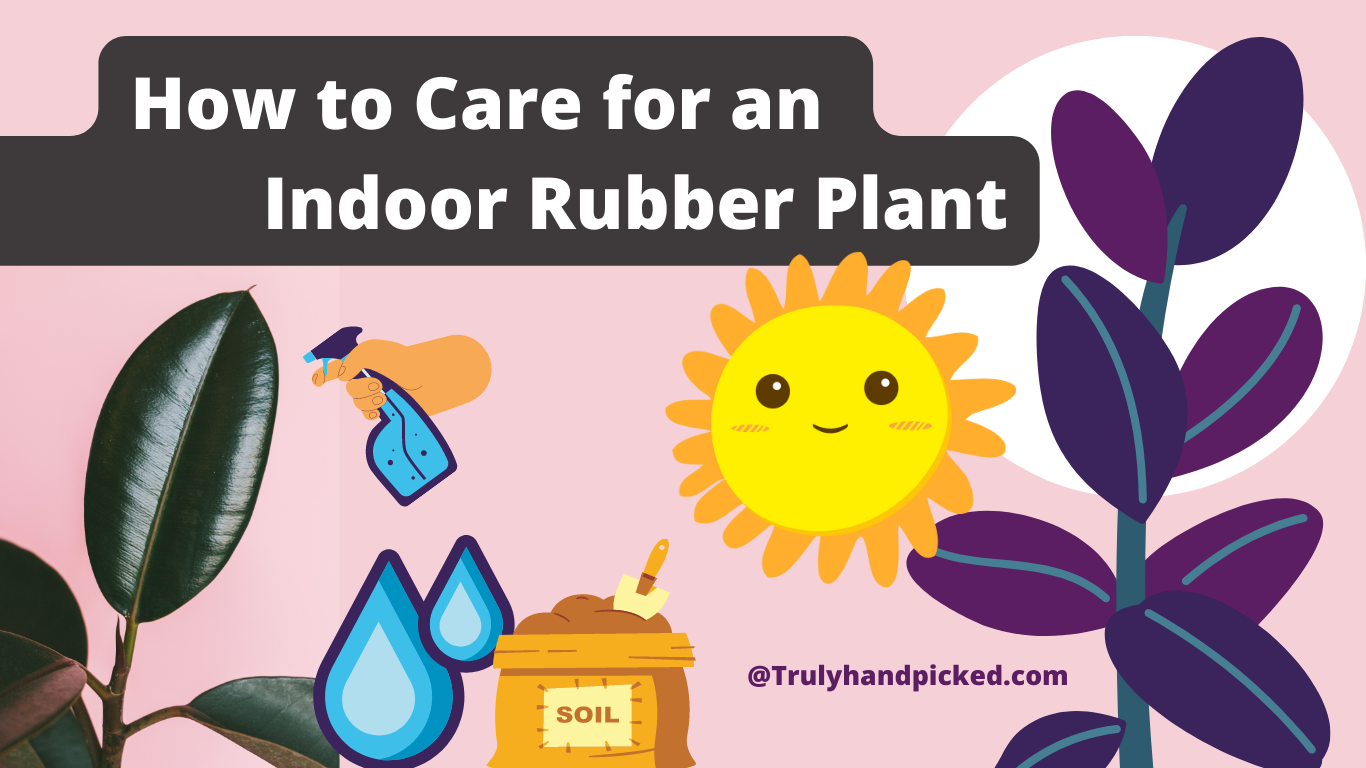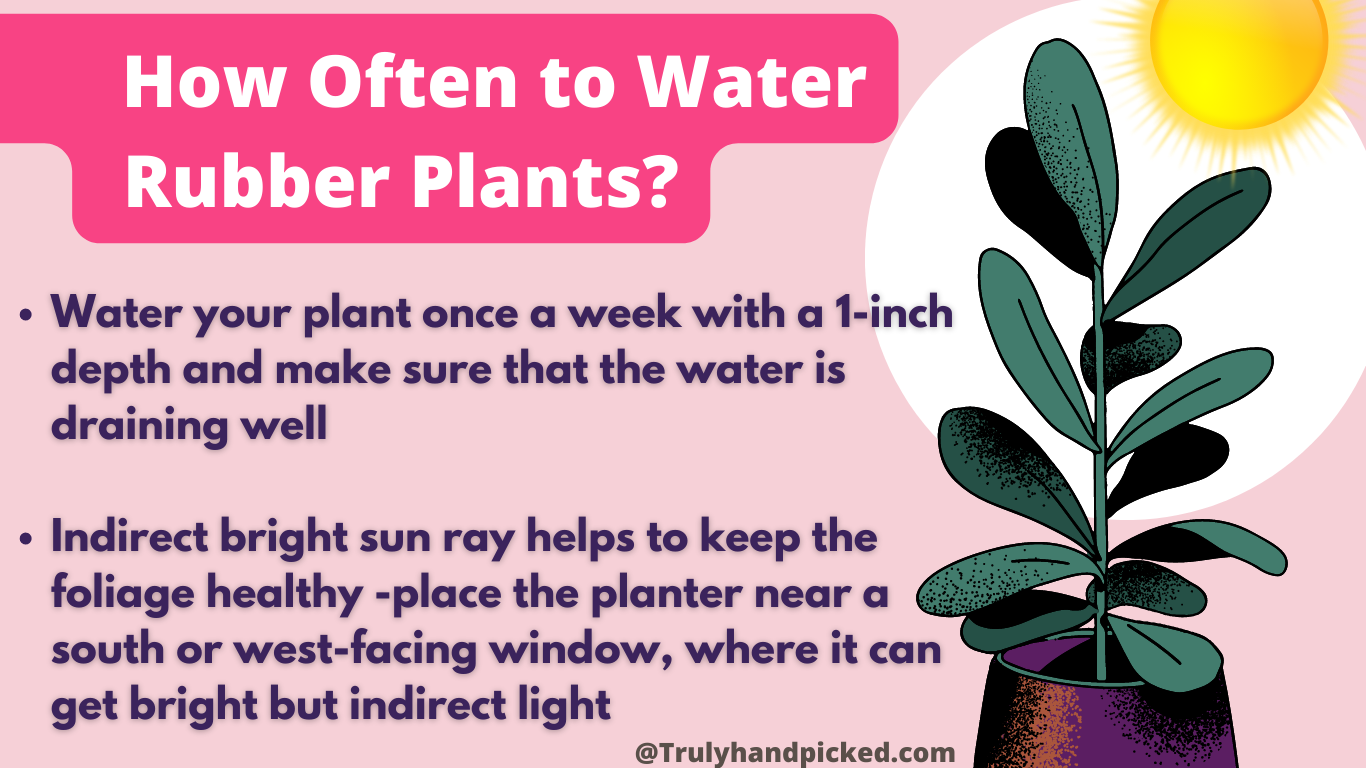Rubber Plants are acidic soil lovers and prefer bright indirect sunlight and balanced fertilizers once a month. Go for well-drained rich soil which is moist and not soggy, like watering once a week and misting occasionally.
Rubber plants (Ficus Elastica/Rubber Tree) can be good houseplants with moderate care and basic gardening requirements. We know that rubber plants can grow big around 45-50 feet tall with adequate space.
But that doesn’t mean you can’t grow this good-looking plant indoors. Rubber plant, also known as Ficus elastica, is an easy-to-grow houseplant that can amplify the beautify of your indoor area outstandingly.
Let’s learn how to cultivate this in a restricted planter and give it a good thrive in this article below-
Benefits of Growing Rubber Plant Indoor?
Ficus Elastica Plant has the advantage of growing indoors. Once you witness its benefit, you will surely be amazed by how a simple ornamental houseplant can turn such beneficial! Some of the common benefits of rubber plants are-
- It can embellish the whole look of your house interior exclusively with its beautiful foliage
- Rubber plant doesn’t have any allergic properties and thus, never provide sensitive reactive to anything or anybody
- A rubber plant is one of those beneficial houseplants, which purify the air and absorb pollutants efficiently
- The rubber plant is one of the most easy-to-grow houseplants that require extremely low-maintenance as well
- Leaves of rubber plants have some miraculous anti-inflammatory compounds. So, you can even treat any kind of skin irritation issue with a couple of mashed rubber plants easily
- And it is safe for your kids as well as house pets as well due to its allergy-free quality.
Love rubber plants for their low maintenance, then give a glance at a list of low-light tolerant indoor plants and trees.
Rubber Plant Care: Quick Overview
- Soil: Rubber plant requires slightly acidic soil that must have well-drained quality. Prepare a good mixture with perlite or coarse sand, peat moss, and organic plant food to make the perfect potting mix.
- Water: Make sure the soil of your indoor rubber plant retains evenly moist, but not soggy. Watering once every 1-2 weeks would be enough to keep your plant healthy.
- Sunlight: Bright and indirect light is something the rubber plant always craves. So, keep your Ficus elastica plant near any south-facing window of your house. You can provide the plant with the direct sun also, but try to cater to it through any shade.
- Fertilizer: Rubber plants are moderate feeders, so, try to feed your indoor rubber plant once a month with any water-soluble balanced fertilizer. Don’t skip the fertilization ever during the primary growing session of your rubber plant.
Best Types of Rubber Plants to Grow as a Houseplant:
If you think about growing a rubber tree as an indoor plant, you can pick from a wide range of options, as there are several types of rubber plant varieties you have in this single species. Here we refer to the best and most beautiful one among them, that can revive the whole resemblance of your house interior proficiently-
Decora:
This is one of the most popular varieties of indoor-growing rubber plants. This species can grow wide with normal rubber plant leaves and can reach up to 1 foot long in a suitable planter.
Doescheri:
If you are looking for the rubber plant with the most attractive leaves, then this is the best pick for you. Doescher rubber plant grows unique-looking foliage in a green shade with pink midrib and pinkish underside designs.
Tricolor:
This category of rubber plant grows leaves with an amazing three-color combination, which makes the name ‘tricolor’ appropriate for this one. The thick and fibrous foliage of this plant display more than beautiful while fully grown in three bright shades of green, pink, and cream.
Red Ruby:
Leaves of this single species grow in the dark green shade with pointy closer. Foliage looks classy due to its piebald hue of purple, red and white colors over the deep green shade. It is probably the best-looking rubber plant option you can have.
Abidjan:
If you want to grow a moderately long rubber plant for your limited indoor area, then this would be the best option for you. This species mostly grows in a single stem with leathery foliage that holds an amazing burgundy-bronze hue.
Some other easy-to-grow Ficus elastica species for indoor are-
- Ficus carica
- Robusta
- Tineke
- Burgundy
- Melany, etc.
How to Care Rubber Plant Expertly:
Soil and Potting Mix:
Prepare a soil mix with 1 part of pine bark, 1 part of peat moss, 1 part of perlite, and 1 part of any normal potting pix soil. Make sure the soil is slightly acidic and contains a pH level between 6.1-6.5. don’t forget to combine the soil well before pouring it into the planter.
Always be attentive about the draining quality of your soil. A water-logged root system of an indoor rubber plant can give you a damaged planting experience, more you could have ever imagined.
Read also: Soil and watering needs of indoor areca palm plants.
How Often to Water Your Rubber Plants:
Your plant needs a moist soil surface consistently to grow vigorously. Remember that your plant may drop leaves and have paused growth due to the dry soil condition.
However, water-logged soil is as bad as a dry one. So, water your plant once a week with a 1-inch depth and make sure that the water is draining well to give your plant the best thrives.
Perfect Climate and Light Requirements:
To give your indoor ficus plants a perfect growing condition, place the planter near a south or west-facing window, where it can get bright but indirect light.
Indirect bright sun ray helps to keep the foliage healthy enough along with making their photosynthesis process perfect. Maintain the temperature between 60 to 75 degrees F throughout the whole day and make sure your plant stays in the hardiness zones 10 to 11.
Proper Fertilization:
Rubber plants prefer balanced liquid fertilizers and they are medium feeders. So, try to feed your indoor Ficus elastica plant once every month to keep it properly nourished.
To the right fertilization, combine ½ teaspoon of any balanced NPK fertilizer with a 10-10-10 ratio in a 5-gallon of water.
Now, use this liquid fertilizer whenever you water your plant 1-2 times in a month and your plant will get its adequate nourishment appropriately.
Quick Indoor Gardener Tips for Rubber Plants
Some other required cate methods to grow a rubber plant healthily indoors are-
- Keep your plant away from heavy wind
- Wipe the fully grown foliage with clean wipers after every few whiles
- Feed your plant more actively during the growing session
- Mist the plant and leaves in low-humidity
- And prune the unwanted parts as soon as you locate them
Rubber Plant Leaves and Pest Issues
There are some typical problems you may witness while growing a rubber plat indoor. Such as-
- Spotted leaves
- Discolored leaves
- Plenty of spider mites over the foliage
- Brownish shell over the leaves
- Infected stem
- Stunned growth
- Leaf-drop
- Curvy leaves
- And growing yellow or brown leaves
Read also: How to revive an overwatered peace lily.
How to care for a dying rubber plant
- Check for the drainage system
- Apply neem oil, rubbing alcohol, baking soda, vinegar, etc. to fight the pes’ infestation
- Isolate the infected plant in time
- Wash the infected leave or stem with soapy water
- Clean the mites or any ugly spread from your leaves individually
- Rinse the entire plat with the splash of plain water
- Trim the infected leaves and stems
- And always find out the exact pest and disease behind the problem and apply the remedy accordingly.
Suggested Video on Rubber Plant Propagation
How to Prune and Propagate Rubber Plant:
Pruning is essential for such widely grown indoor plat to keep them healthy and in shape consistently. You can even propagate this plant easily following some easy steps. Look for the time your plant outgrew the planter to propagate. You can even do this during spring and summer too, as these are the best time for pruning and propagating rubber plants. To do the process perfectly, follow these steps attentively-
- Take a hedge shear or plant scissor and cut off the top of the plant consisting of a small portion from the stem along a couple of leaves
- You can also select the leggy or elongated stems to cut and propagate
- Don’t forget to wear protective materials to keep yourself clean from the messy sap of a rubber plant
- Now, clean the end with a clean paper towel to make the dropping sap stop first
- Then, pluck the bottom leaves and plant the cutting into a new planter prepared with a perfect potting mix as well as fertile soil that is required for a healthy rubber plant
- Finally, place your planter in a warm and sunny location after watering thoroughly and see how beautifully you will get a new clone of rubber plant within a couple of weeks.
You may also be interested in jade plant propagation and care.
Pinterest image on growing rubber plants: Watering, soil, light requirements
How to Repot Rubber Plant:
To report your fully grown indoor rubber plant, follow these rules below-
- Take out the plant first along with the entire soil and undamaged roots
- Lose the roots a little from the tight grasp of soil and keep it aside
- Now, take a new and bigger pot with a drainage hole at the closer
- Place a 3-4 inches layer of soil mixed with fertile potting mix
- Set the rubber plant with its entire roots into the new pot and fill the around with the rest potting mix properly
- Secure the top surface with plenty of soil mix and water the plant thoroughly
- Wait until the excess water drains from the drainage hole and then, put the planter in a warm sunny spot for a week.




